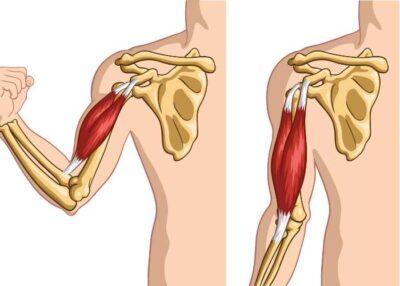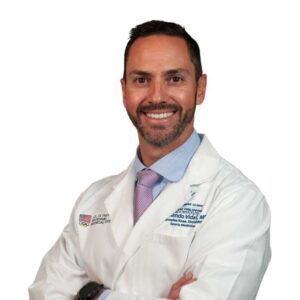What is the biceps tendon?
The biceps muscle is located in the front of the upper arm. This important muscle is used countless times a day and relied on for a large and diverse range of activities. The biceps muscle and biceps tendon flex the elbow and rotate the forearm and wrist. The muscle has two tendons that attach the muscle to the bones in the shoulder. The long head biceps tendon goes into the shoulder joint and attaches to the top of the glenoid (shoulder socket). The short head biceps tendon attaches to the coracoid process, which is a bump on the front of the shoulder blade. At the bottom of the biceps muscle is another tendon, which attaches the muscle to the radius bone at the elbow. These tough strips of tissue, connecting muscle to bone, allow the arm to move.

What are biceps tendon disorders?
Biceps tendon disorders can occur from activities that use repetitive motions, overuse, lifting heavy objects overhead or falling on an outstretched arm. A biceps tendon injury or disorder can occur when the tendon frays or tears away from one of its attachment sites. Often, if a biceps tendon is injured, patients in Vail, Aspen and the surrounding Denver, Colorado communities can have a problem with their rotator cuff. Dr. Armando Vidal, orthopedic shoulder specialist, treats biceps tendon disorders and has extensive experience in treating biceps tendon injuries.
Biceps tendon disorders fall into four categories:
- Biceps Tendinitis: Inflammation of the tendon, specifically where the long head (upper part) of the biceps tendon is irritated and causes pain. Biceps tendinitis occurs most commonly in athletes who repeatedly place strain on the muscle or overuse the muscle. Pain from biceps tendinitis is typically felt in the front of the shoulder where the tendon travels near the rotator cuff on the superior labrum within the shoulder.
- Partial Biceps Tear: Occurs when the tendon is worn or “frayed” from repetitive use and may not be torn completely.The tendon becomes irritated and inflamed.
- Complete Biceps Tear or Rupture: the tendon is torn into two pieces.This can occur from continuous wearing of a partial tear, or from an injury that divides the tendon in two.
- Biceps tendon dislocation: The tendon resides in a groove in the front of the shoulder and can be displaced.This typically results in pain and / or a popping sensation in the front of the shoulder.
What are the symptoms of biceps tendon disorders?
Biceps tendon disorders have several things in common and there are several warning signs associated with a biceps tendon injury. Tears of the long head of the biceps tendon (that attaches inside the shoulder) are most common. Tears of the short head of the biceps tendon are rare. Common symptoms to watch for are:
- Sudden, intense pain in the upper arm or site of the tear. The pain may resolve in a few days.
- Hearing or feeling a “pop” at the time of injury
- Cramping in the biceps muscle
- Pain and tenderness at the shoulder and/or elbow
- Bruising
- A physical change in the front of the arm, sometimes a bulge due to the fact the tendon is no longer holding the muscle in place. This is commonly called a “Popeye muscle.”
- Muscle weakness in the arm
- Decreased range of motion
How are biceps tendon disorders diagnosed?
For patients in Vail, Aspen and the surrounding Denver, Colorado communities, Dr. Vidal will perform a physical examination. If a torn biceps tendon is suspected, he may request and MRI Scan. The scan will also allow him to see any rotator cuff involvement as well as other soft-tissue damage.
How are biceps tendon disorders treated?
Non-Surgical Treatment:
For biceps tendon injuries or disorders that are minor, treatment with ice, rest and anti-inflammatory medication will be prescribed. Tendinitis and partial tendon ruptures may not require surgery; some tendon tears may be associated with rotator cuff tears. Dr. Vidal will advise patients to avoid heavy lifting and strenuous activity until the tear heals completely. Physical therapy is then recommended to regain strength and flexibility to the shoulder.
Surgical Treatment:
Biceps tendon injuries and disorders do not always require surgical intervention. Dr. Vidal will discuss patient options based on age, activity level and severity of the injury. Biceps tendon tears that occur near the elbow almost always require surgery and should occur within a week or two of the injury.
Biceps tendon tears at the shoulder can be repaired with a minimally invasive surgery called arthroscopic repair. Dr. Vidal is experienced in complex shoulder procedures and would use small incisions to re-anchor the torn tendon back to the bone. If only a small part of the tendon is torn, a simple smoothing, or debridement of the torn fibers may be all that is required. If a large portion of the tendon is torn, the damaged part may be removed from inside the shoulder joint and then the remaining tendon would be attached to the humerus (upper arm bone), allowing the tendon to work normally again. This procedure is called biceps tenodesis.
Biceps Tendon Specialist
Do you perform work that involved frequent heavy lifting? If so, you may be at risk of developing a biceps tendon disorder. These disorders include tendonitis, a tear, or dislocation of the biceps, any of which can cause pain and decreased strength in the affected arm. Tendon specialist, Doctor Armando Vidal provides diagnosis and treatment for patients in Vail, Aspen, and the surrounding Denver, Colorado communities who have experienced a biceps tendon injury. Contact Dr. Vidal’s team today!

Locations
180 S Frontage Rd W
Vail, CO 81657
226 Lusher Court
Ste 101
Frisco, CO 80443
322 Beard Creek Road
Edwards, CO 81632


